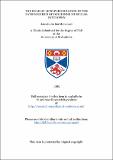Files in this item
The role of lipid peroxidation in the pathogenesis of Duchenne muscular dystrophy
Item metadata
| dc.contributor.advisor | Hunter, Marcus Ian Stuart | |
| dc.contributor.author | Mohamed, Jamaludin bin | |
| dc.coverage.spatial | 272 p. | en_US |
| dc.date.accessioned | 2018-06-25T08:34:52Z | |
| dc.date.available | 2018-06-25T08:34:52Z | |
| dc.date.issued | 1985 | |
| dc.identifier.uri | https://hdl.handle.net/10023/14506 | |
| dc.description.abstract | Duchenne muscular dystrophy (DMD) is a progressive muscle disease which is eventually fatal due usually to respiratory and cardiac failure. Although DMD is known to be an inherited, X-linked, disease the nature of the genetic defect remains elusive. Biochemical and histological evidence points to a lesion in the cell membranes of muscle and possibly other cell types although the nature of this lesion has not been elucidated. One of the many theories is that membrane lipid peroxidation causes the membrane damage and consequent necrosis seen in DMD. The aim of this work was to search for evidence relating to this theory using cultured skin fibroblasts (CSFs) and blood plasma. It was demonstrated that whole cultures of DMD CSFs, show markedly increased MDA production which distinguished them from normal control CSFs. Both CSFs grown in a medium without PUFA and with PUFA showed that lipid peroxidation occurs in a time-dependent manner and higher levels of MDA were found in control and EMD CSFs incubated in PUFA. It was also found that washed CSFs showed a considerable increase in MDA production compared with unwashed ones. The concentration of tert-butyl hydroperoxide (TBH) which is just below the minimum toxic level for CSFs was determined and found to be 50mumol/l. Although lipid peroxidation products (MDA and FP) were not significantly different in the washed particulate fraction from DMD and normal control CSFs, these products (CD, MDA and FP) were significantly higher in total homogenates from EMD compared with normal control CSFs suggesting that membrane lipid peroxidation may not be entirely membrane-dependent but also probably involves cytoplasmic components. Protection by a GSH-dependent cytosolic factor from CSFs against lipid peroxidation in a model system was examined. This work strongly indicates that DMD CSFs have a better protection system than normal controls. All three lipid peroxidation products (CD, MDA and FP) were measured in plasma and found to be significantly Increased in DMD (P<0.02; P<0.01; P<0.001 respectively) compared with normal control. The stability of the products (CD, MDA and FP) in EMD and normal control plasma was examined during storage for up to 3 years at -20°C. There was a significant increase of MDA and FP concentrations with time but no significant changes in CD for both DMD and controls with time of storage. There was a significant positive correlation between MDA. concentration and age but not for CD and FP concentrations. Total plasma antioxidant activity (AOA) is markedly higher in DMD (76%) than in normal controls (63%) and significantly different (P<0.001). AOA and MDA were positively significantly correlated (P<0.05) in EMD plasma. Plasma vitamin E concentration is significantly lower (P<0.002) in EMD than in normal controls (4.14+/-,2.00 compared to 9.30+.2.45 mg/litre) but not significantly correlated with plasma AOA (P>0.05). A general but small decrease in alpha-tocopherol was seen in both EMD and control during storage (-20°C) up to 3 years. There was no correlation between age and vitamin E concentration for a group of adults (ages 18-35) and children (ages 3-14). Lastly plasma transferrin concentration shows no significant difference between DMD and normal controls (P>0.05) but a significant increase in caeruloplasmin was found in DMD patients compared with normal controls (P<0.001). Neither levels of transferrin nor caeruloplasmin (in IWD and normal controls) were influenced by time of storage (-20°C). Further both proteins showed no significant difference with age of subject. | en_US |
| dc.language.iso | en | en_US |
| dc.publisher | University of St Andrews | |
| dc.subject.lcc | QP552.L5M7 | |
| dc.subject.lcsh | Lipoproteins | en |
| dc.title | The role of lipid peroxidation in the pathogenesis of Duchenne muscular dystrophy | en_US |
| dc.type | Thesis | en_US |
| dc.type.qualificationlevel | Doctoral | en_US |
| dc.type.qualificationname | PhD Doctor of Philosophy | en_US |
| dc.publisher.institution | The University of St Andrews | en_US |
This item appears in the following Collection(s)
Items in the St Andrews Research Repository are protected by copyright, with all rights reserved, unless otherwise indicated.

